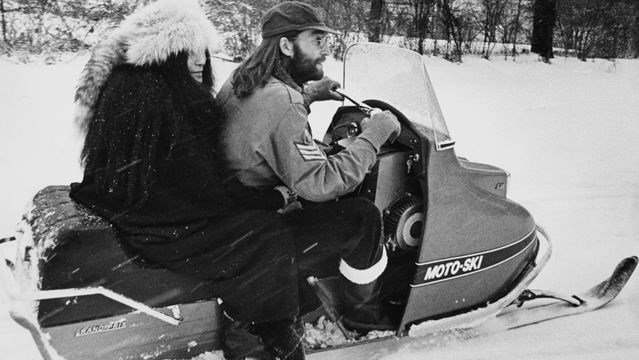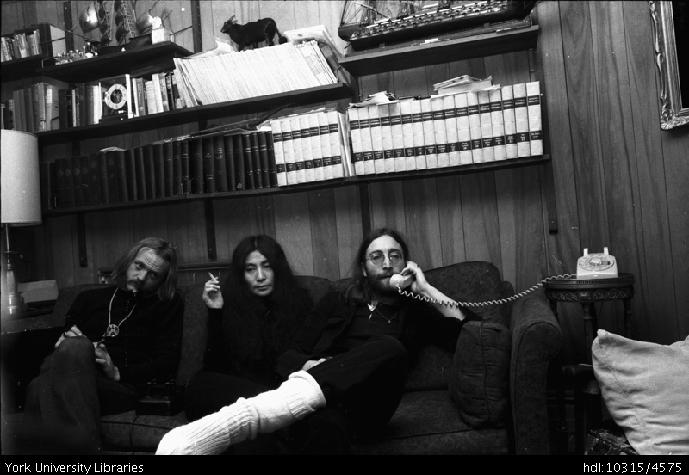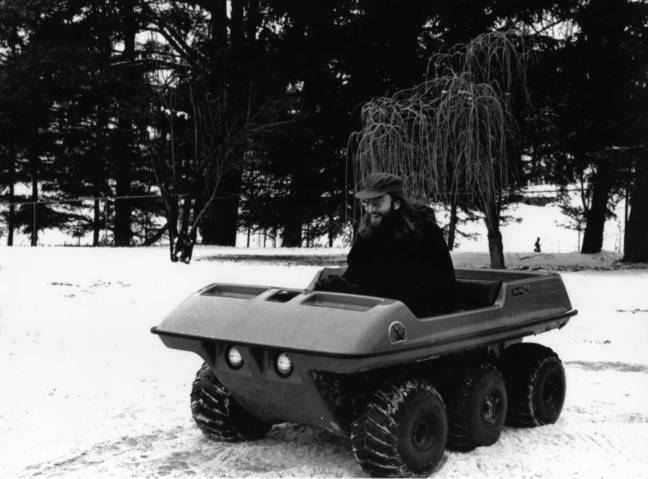The end of The Beatles’ long and winding road came into view in the secluded woods of Mississauga.
It was the week before Christmas 1969 and the world’s most famous couple, John Lennon and Yoko Ono, were staying at Ronnie and Wanda Hawkins’ Braeburn estate, north-west of Burnhamthorpe and Mississauga Roads.
John and Yoko’s heat score was red hot following their March 1969 marriage and headline-grabbing ‘bed-in’ anti-war protest at Montreal’s Queen Elizabeth Hotel in May.
Plus, there were all those rumours about the Fab Four and whether The Beatles, the world’s biggest band, would continue to come together once the 1960s were done.
It was a lot, and so when Ritchie York, Rolling Stone magazine’s Canadian writer, suggested the pair take some time to chill at the Hawkins’ property in what was then rural Ontario, John and Yoko gladly accepted the invitation.

Yoko Ono and John Lennon try out snowmobiling for the first time at Braeburn, Ronnie and Wanda Hawkins’ Mississauga home. (Photo courtesy of Heritage Mississauga)
While Lennon and Hawkins knew each other’s music, they had never met in-person. Hawkins was the boisterous American rockabilly guitarist who, 11 years earlier, had moved to Canada where he earned a reputation for ripping it up on stage and having an eye for talent.
He and his backup band, The Hawks, “the most wicked rock ‘n’ roll band around” schooled their audiences in the sound and style of Rompin’ Ronnie’s southern rockabilly roots.
Fellow southerner and drummer Levon Helm had followed Hawkins to Canada and he was soon joined by a quartet of southern Ontario musicians: Garth Hudson, Richard Manuel, Rick Danko and Robbie Robertson.
Hawkins had first heard Robertson when the 16-year-old and his band The Suedes opened for Hawkins at a concert at Dixie Arena in the 1950s.
In 1964 the quintet and Hawkins parted ways. Hawkins continued to play and perform in Canada, mentoring other musicians such as Lawrence Gowan, David Clayton-Thomas and David Foster.
The band moved to New York State, toured with Bob Dylan, and then struck out on their own as The Band, releasing Music From Big Pink in 1968. That album changed rock and roll, inspiring artists such as Eric Clapton, Elton John – and Paul McCartney. .

Rolling Stone journalist Ritchie Yorke (left) suggested Yoko Ono and John Lennon chill out at Ronnie and Wanda Hawkins’ Mississauga property as they planned their anti-peace campaign in December 1969. (Photo courtesy of Heritage Mississauga)
Fearing Lennon was slipping away, McCartney convinced George Harrison, Ringo Starr and Lennon to come together to write songs that toned down the experimentation of the White Album in favour of more straightforward rock and roll arrangements, similar to the sound of Hawkins’ former bandmates, The Band.
However, the January 1969 sessions were filled with tension and when the Let It Be album was finally completed, the quartet walked away from each other, more distant than ever.
They would return to the recording studio one last time in July to record Abbey Road. A week before its release in September 1969, Lennon told his bandmates he was done.
The Beatles were never together in the same room again.
It was against this backdrop of swirling emotions and the disentanglement of The Beatles that Lennon and Ono drove up Hawkins’ snow-covered laneway.
Hawkins had purchased Braeburn, located at 1959 Folkway Drive, in 1967, a rural retreat less than an hour’s drive from the kinetic energy of Yonge Street where Hawkins had made his name in Canada.

John Lennon zooming around Braeburn, Ronnie and Wanda Hawkins’ home near Mississauga Road in December 1969. (Photo courtesy of Heritage Mississauga)
Lennon and Ono stayed at Braeburn from December 16-22, 1969, bringing with them a small entourage and 16 newly installed phone lines, on which Ono called influential friends, such as Princess Margaret, and planned the couple’s ‘War is Over’ billboard and radio campaign.
While at Braeburn, Lennon found time to relax. He zoomed around the property on Hawkins’ snowmobile, signed copies of his Bag One erotic lithographs, and smoked up while chatting with friends and friendly journalists, including Ray Connolly, the music columnist for the London Evening Standard.
During that conversation, Lennon casually confirmed what music fans feared: Lennon had left The Beatles.
Lennon used his time at Braeburn to sketch out his next role as peace activist.
He and Ono travelled downtown to meet with University of Toronto superstar media theorist Marshall McLuhan at his offices near Queen’s Park, appeared on CBC Television, rang up a $6,000 phone bill calling famous friends around the world, and overfilled the second-floor bathtub so much the first-floor ceiling collapsed.
Despite the shortness of their visit, the couple had a profound effect on Hawkins, who accompanied them on their VIA Rail train journey to Ottawa to meet Prime Minister Pierre Trudeau.
Hawkins would go on to become one of their high-profile peace ambassadors, travelling with Yorke to the China-Hong Kong border with John and Yoko’s anti-war message.
Let it Be, the album that took inspiration from The Band’s stripped back sound, was released in May 1970, a month after The Beatles publicly announced their break-up.
Years later, Lennon would recall his time at Braeburn with Hawkins as a peaceful and idyllic time amidst the tumult of The Beatles’ demise.
You can hear more stories about the people and events that helped shape Mississauga via our podcast, We Built This City: Tales of Mississauga, available on your favourite podcast platform or from our website.
